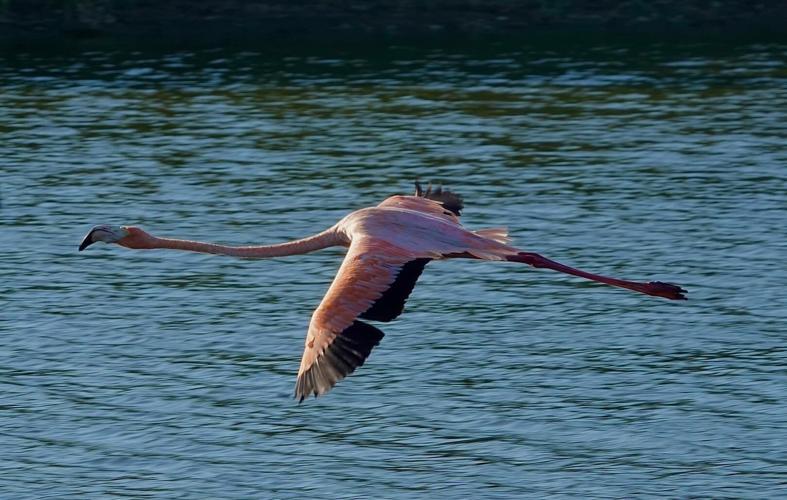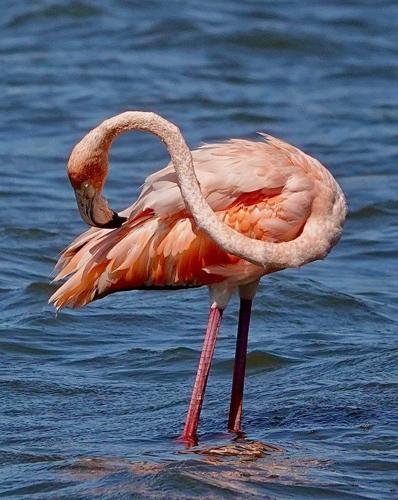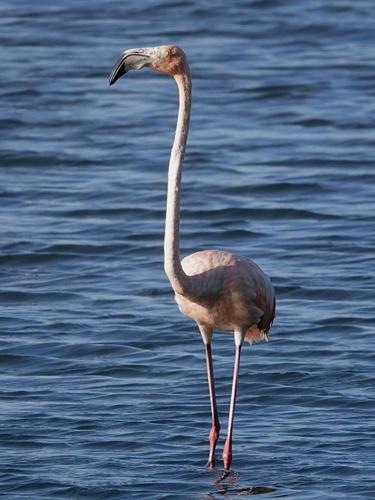New Orleans resident Jennifer Coulson received an unusual text first thing in the morning last Friday: A flamingo was spotted in New Orleans East.
Coulson, true to her birder nature, got the text at 8:50 a.m. and was out at the Bayou Sauvage Urban National Wildlife Refuge within 40 minutes.
When she got there, she said she almost couldn't believe her eyes. As the president of the Orleans Audubon Society and an ornithologist, Coulson has seen over 1,000 species of birds. But this American flamingo, with its bright pink feathers and 5-foot wingspan, was a first for her.
And to see it at home New Orleans of all places.
"It's just so stunning," Coulson said.
Ever since the first photo of a flamingo wading through a New Orleans marsh hit social media last week, hordes of birders and other curious residents have been flocking to the Bayou Sauvage area with cameras and binoculars, hoping to catch a glimpse of our strange visitor.
How did the flamingo get to New Orleans?
The New Orleans flamingo is thought to be one of the many stragglers that were caught up in the winds of Hurricane Idalia as it tore through Florida's Big Bend region in August, scattering the usually nonmigratory birds around the U.S.
American flamingos are commonly found in Mexico and Cuba, but sightings in states from Ohio to Alabama became increasingly common in the weeks following the storm.
When Coulson confirmed that the big pink bird in question was in fact a flamingo and not a Roseate spoonbill, she immediately messaged all the fellow birders she could think of. Soon, the land surrounding what people are now calling "Flamingo Pond" was clustered with flamingo paparazzi, birders Coulson hadn't seen in ages or had only ever chatted with online.
“It was like a little birder reunion on the side of the road," she said.

Birders line up at the edge of what locals are now calling "Flamingo Pond," hoping to catch a glimpse of a lone American flamingo that was first spotted in New Orleans around Friday, Sept. 29, 2023.
Now that the flamingo has been spotted in the same body of water every day for a week, interested parties are speculating as to how long it might stick around, and if it does, how it will survive.
Will the flamingo survive in Louisiana?
Despite Louisiana's predators — there were a few moments of intense anxiety last Friday when Coulson and other birders watched as a 7-foot alligator approached the flamingo, followed by a bald eagle — the flamingo appears to be content where it is.

An alligator swims away from a flamingo near Bayou Sauvage Urban National Wildlife refuge on Friday, Sept. 29, 2023.
Coulson said some birders think the flamingo could be eating grass shrimp, tiny shrimp that are commonly found in estuaries and some fresh bodies of water along the Gulf Coast.
“It seems to be working over the same area," Coulson said, "so I think the reason it's staying is it must be finding food.”
Steven Whitfield, director of terrestrial and wetlands conservation at the Audubon Nature Institute, became somewhat of a flamingo expert after leading a flamingo conservation project for eight years in south Florida, the only part of the U.S. where the birds are native.
Though flamingos famously get their pink coloring from the shrimp they eat, Whitfield said the birds' diets are actually quite broad, ranging from crustaceans and insects to plants, seeds and algae. Compounds found in some of those other snacks also play a roll in giving flamingos their unique coloring.
How long will the flamingo stay in New Orleans?
So, Whitfield said, depending on what the flamingo is eating and how long it stays, it's entirely possible it could keep its pink feathers. Whitfield pointed to another lost flamingo that landed in a wildlife refuge near Tallahassee after Hurricane Michael in 2018.
It's still there and it's still pink, he said.
But most birders, including Whitfield, said the flamingo is more likely than not to move on. Flamingos like to live in flocks and are good at finding each other no matter how far from home they might be, Whitfield said.
It's possible this flamingo is one that was initially pushed farther north after Idalia and is now on its way back to the coast, stopping briefly for some rest and food, he said.
Whatever happens, Whitfield said he's excited to get another chance to study flamingos.
"This was definitely an unusual event," he said.






